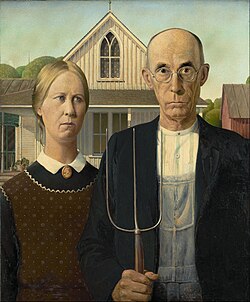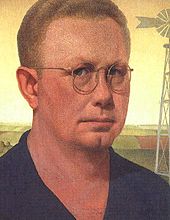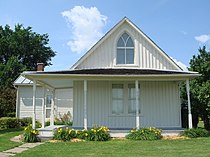| Revision as of 10:57, 26 December 2014 edit2.28.194.133 (talk)No edit summary← Previous edit | Revision as of 11:46, 26 December 2014 edit undoModernist (talk | contribs)Autopatrolled, Extended confirmed users, Pending changes reviewers, Rollbackers106,216 editsm Reverted edits by 2.28.194.133 (talk) to last version by RugdocotrphdNext edit → | ||
| Line 14: | Line 14: | ||
| }} | }} | ||
| '''''American Gothic''''' is a ] by ] in the collection of the ]. Wood's inspiration came from what is now known as the ], and his decision to paint the house along with "the kind of people I fancied should live in that house."<ref name=fineman>Fineman, Mia, , '']'', 8 June 2005</ref> The painting shows a farmer standing beside his |
'''''American Gothic''''' is a ] by ] in the collection of the ]. Wood's inspiration came from what is now known as the ], and his decision to paint the house along with "the kind of people I fancied should live in that house."<ref name=fineman>Fineman, Mia, , '']'', 8 June 2005</ref> The painting shows a farmer standing beside his ] daughter.<ref name="about">{{cite web | title=About This Artwork: American Gothic | url=http://www.artic.edu/aic/collections/artwork/6565 | publisher=The Art Institute of Chicago | accessdate=June 20, 2010| archiveurl= http://web.archive.org/web/20100528093948/http://www.artic.edu/aic/collections/artwork/6565| archivedate= 28 May 2010 <!--DASHBot-->| deadurl= no}}</ref> The figures were modeled by the artist's sister and their dentist. The woman is dressed in a ] print apron evoking 19th-century ], and the couple are in the traditional roles of men and women, the man's ] symbolizing hard labor, and the flowers over the woman's right shoulder suggesting domesticity. | ||
| It is one of the most familiar images in 20th-century ],<ref name="fineman"/> and has been widely parodied in American ]. | It is one of the most familiar images in 20th-century ],<ref name="fineman"/> and has been widely parodied in American ]. | ||
Revision as of 11:46, 26 December 2014
For other uses, see American Gothic (disambiguation).| American Gothic | |
|---|---|
 | |
| Artist | Grant Wood |
| Year | 1930 |
| Type | Oil on beaverboard |
| Dimensions | 74.3 cm × 62.4 cm (29¼ in × 24½ in) |
| Location | Art Institute of Chicago |
American Gothic is a painting by Grant Wood in the collection of the Art Institute of Chicago. Wood's inspiration came from what is now known as the American Gothic House, and his decision to paint the house along with "the kind of people I fancied should live in that house." The painting shows a farmer standing beside his spinster daughter. The figures were modeled by the artist's sister and their dentist. The woman is dressed in a colonial print apron evoking 19th-century Americana, and the couple are in the traditional roles of men and women, the man's pitchfork symbolizing hard labor, and the flowers over the woman's right shoulder suggesting domesticity.
It is one of the most familiar images in 20th-century American art, and has been widely parodied in American popular culture.
Creation
In August 1930, Grant Wood, an American painter with European training, was driven around Eldon, Iowa by a young painter from Eldon, John Sharp, looking for inspiration. Wood noticed the Dibble House, a small white house built in the Carpenter Gothic architectural style. Sharp's brother suggested in 1973 that it was on this drive that Wood first sketched the house on the back of an envelope. Wood's earliest biographer, Darrell Garwood, noted that Wood "thought it a form of borrowed pretentiousness, a structural absurdity, to put a Gothic-style window in such a flimsy frame house." At the time, Wood classified it as one of the "cardboardy [sic] frame houses on Iowa farms" and considered it "very paintable". After obtaining permission from the Jones family, the house's owners, Wood made a sketch the next day in oil on paperboard from the house's front yard. This sketch displayed a steeper roof and a longer window with a more pronounced ogive than on the actual house, features which eventually adorned the final work.
Wood decided to paint the house along with "the kind of people I fancied should live in that house." He recruited his sister Nan (1899–1990) to model the woman, dressing her in a colonial print apron mimicking 19th-century Americana. The man is modeled on Wood's dentist, Dr. Byron McKeeby (1867–1950) from Cedar Rapids, Iowa. The three-pronged hay fork is echoed in the stitching of the man's overalls, the Gothic window of the house, and the structure of the man's face. However, Wood did not add figures to his sketch until he returned to his studio in Cedar Rapids. He would not return to Eldon again before his death in 1942, although he did request a photograph of the home to complete his painting.
Reception

Wood entered the painting in a competition at the Art Institute of Chicago. The judges deemed it a "comic valentine", but a museum patron persuaded them to award the painting the bronze medal and $300 cash prize. The patron also persuaded the Art Institute to buy the painting, which remains there today. The image soon began to be reproduced in newspapers, first by the Chicago Evening Post and then in New York, Boston, Kansas City, and Indianapolis. However, Wood received a backlash when the image finally appeared in the Cedar Rapids Gazette. Iowans were furious at their depiction as "pinched, grim-faced, puritanical Bible-thumpers". Wood protested that he had not painted a caricature of Iowans but a depiction of his appreciation, stating "I had to go to France to appreciate Iowa." Nan, apparently embarrassed at being depicted as the wife of someone twice her age, began telling people that the painting was of a man and his daughter, which Grant seems to confirm in his letter to a Mrs. Nellie Sudduth in 1941.
Art critics who had favorable opinions about the painting, such as Gertrude Stein and Christopher Morley, also assumed the painting was meant to be a satire of rural small-town life. It was thus seen as part of the trend toward increasingly critical depictions of rural America, along the lines of Sherwood Anderson's 1919 Winesburg, Ohio, Sinclair Lewis's 1920 Main Street, and Carl Van Vechten's 1924 The Tattooed Countess in literature.
Yet another interpretation sees it as an "old-fashioned mourning portrait... Tellingly, the curtains hanging in the windows of the house, both upstairs and down, are pulled closed in the middle of the day, a mourning custom in Victorian America. The woman wears a black dress beneath her apron, and glances away as if holding back tears. One imagines she is grieving for the man beside her..." Wood had been only 10 when his father had died and later had lived for a decade "above a garage reserved for hearses", so death was on his mind.
However, with the onset of the Great Depression, the painting came to be seen as a depiction of steadfast American pioneer spirit. Wood assisted this transition by renouncing his Bohemian youth in Paris and grouping himself with populist Midwestern painters, such as John Steuart Curry and Thomas Hart Benton, who revolted against the dominance of East Coast art circles. Wood was quoted in this period as stating, "All the good ideas I've ever had came to me while I was milking a cow."
Parodies


The Depression-era understanding of the painting as a depiction of an authentically American scene prompted the first well-known parody, a 1942 photo by Gordon Parks of cleaning woman Ella Watson, shot in Washington, D.C.
American Gothic is one of the few paintings to achieve iconic cultural status, along with Leonardo da Vinci's Mona Lisa and Edvard Munch's The Scream. It is thus one of the most reproduced – and parodied – images ever made. Many artists have replaced the two people with other known couples and replaced the house with well-known houses.
References and parodies of the image have been numerous for generations, appearing regularly in such media as postcards, magazines, animated cartoons, advertisements, comic books, album covers, television shows and other artists. The opening credits of the 1965 television show Green Acres had the main couple in an American Gothic-style pose; cinematic posters of the films For Richer or Poorer, Son In Law, American Gothic, and Good Fences parody the painting. It is also a key motif in Anthony Weigh's play 2,000 Feet Away, which opens with a scene featuring the painting at the Art Institute. The painting was also parodied in a classic commercial for "New Country Corn Flakes", a General Mills product.
A sculpture entitled "God Bless America" by sculptor John Seward Johnson II that features the American Gothic couple went on display in Chicago, Illinois, just south of the Tribune Tower on the Magnificent Mile of Michigan Avenue, in December 2008 but has been removed as of February 26, 2010. The sculpture was displayed in Dubuque, Iowa at the Figge Art Museum and is now on the campus of Simpson College in Indianola, Iowa until at least December 31, 2013. Postcards mimicking the couple with sitting US Presidents, Presidential nominees, and their spouses are popular commercial products. Ohio State Buckeyes football games feature the painting on their scoreboard; within a few seconds of its display, the man's eyes bug out and his tongue wags.
A 1963 Saturday Evening Post cover featured the cast of The Beverly Hillbillies in a parody of American Gothic with Irene Ryan and Buddy Ebsen posing like the 2 people in the painting flanked by Max Baer and Donna Douglas at their sides.
David Ackles borrowed the title for his 1973 American Gothic album, as did The Smashing Pumpkins for their 2008 EP American Gothic and a 1995 television horror series created by Shaun Cassidy. Elton John and RuPaul portray the couple on the video for a rerecording of "Don't Go Breaking My Heart" released in 1994. Astrovamps parodied the painting on the cover of their album, American Gothik. The Ma and Pa couple at the beginning of the Doctor Who episode "Gridlock" are fashioned in the style of the couple in the painting. The American Gothic couple have even been reinterpreted as Living Dead Dolls twice, in 2004 and 2009.
In the opening scene of The Rocky Horror Picture Show, Richard O'Brien and Patricia Quinn appear as a farmer and his wife in parody of American Gothic. They are joined by a daughter dressed in the same fashion. The painting is also seen on the wall in the castle during the song "Time Warp" as well as it is seen in the sequel Shock Treatment
In the episode of The Simpsons, "Bart Gets an Elephant", the Simpsons are revealed to evidently have the original American Gothic painting hanging on their living room wall. Bart unwittingly scrubs it while cleaning the house, and rubs off all the paint. Underneath, it reads "If you can read this, you scrubbed too hard. Signed, Grant Wood."
In the scene where Mulan's ancestors awaken Mushu in Mulan, two of the ancestors appear as a parody of the farmer and his daughter, representing traditional values.
The painting and its process of creation was parodied in a Saturday Night Live episode, which aired November 10, 2012, with host Anne Hathaway as Nan Wood Graham, Jason Sudeikis as Dr. Byron McKeeby, Tarran Killam as Grant Wood, and Kenan Thompson as a tour guide at The Art Institute of Chicago.
In season 6 episode 7 of the Showtime series Dexter entitled Nebraska, Dexter Morgan and his brother Brian Moser parody the painting by standing next to each other in front of a picture of the Dibble House while Dexter is holding a pitch fork.
See also
References
- ^ Fineman, Mia, The Most Famous Farm Couple in the World: Why American Gothic still fascinates., Slate, 8 June 2005
- ^ "About This Artwork: American Gothic". The Art Institute of Chicago. Archived from the original on 28 May 2010. Retrieved June 20, 2010.
{{cite web}}: Unknown parameter|deadurl=ignored (|url-status=suggested) (help) - ^ "American Gothic House Center". Wapello County Conservation Board. Archived from the original on June 18, 2009. Retrieved July 14, 2009.
{{cite web}}: Unknown parameter|deadurl=ignored (|url-status=suggested) (help) - Garwood, p. 119
- Qtd. in Hoving, p. 36
- ^ Semuels, Alana (April 30, 2012). "At Home in a Piece of History". Los Angeles Times. Retrieved February 25, 2013.
- Dr Byron H. McKeeby at Find a Grave
- "Grant Wood's American Gothic". Smarthistory at Khan Academy. Retrieved December 18, 2012.
- Qtd. in Biel, p. 22
- Andréa Fernandes. "mental_floss Blog » Iconic America: Grant Wood". Mentalfloss.com. Retrieved 2010-04-12.
- "Grant Wood's Letter Describing American Gothic". Campsilos.org. Retrieved 2010-04-12.
- Deborah Solomon (October 28, 2010). "Gothic American". The New York Times.
- "New Country Corn Flakes TV Commercial". LikeTelevision. Retrieved 28 April 2012.
- "Public Art in Chicago: God Bless America". Chicago-outdoor-sculptures.blogspot.com. 2008-12-11. Retrieved 2010-04-12.
- Cochran, Jay; Living Dead Dolls Presents American Gothic Return To Spencers!, 2009-09-19. Retrieved 2010-02-07.
- Saturday Night Live Video, American Gothic, NBC Retrieved 2012-11-18
Works
- Steven Biel (2005). American Gothic: A Life of America's Most Famous Painting. W. W. Norton & Company. ISBN 0-393-05912-X.
- Garwood, Darrell (1944). Artist in Iowa: A Life of Grant Wood. New York: W. W. Norton & Company. OCLC 518305.
- Hoving, Thomas (2005). American Gothic: The Biography of Grant Wood's American Masterpiece. New York: Chamberlain Bros. ISBN 1-59609-148-7.
- André Girod: American Gothic, l'Harmattan, Paris 2014 http://www.editions-harmattan.fr/index.asp?navig=catalogue&obj=livre&no=44613
External links
| External videos | |
|---|---|
 | |
- Grant Wood and Frank Lloyd Wright Compared
- About the painting, on the Art Institute's site
- Slate article about American Gothic
- American Gothic, French
- American Gothic: A Life of America's Most Famous Painting
- Television Commercials (1950s-1960s) contains General Mills New Country Corn Flakes commercial
- American Gothic sculpture removed from Michigan Avenue
- American Gothic Parodies collection
- November 18, 2002, National Public Radio “Morning Edition” report about “American Gothic” by Melissa Gray that includes an interview with Art Institute of Chicago curator Daniel Schulman.
- June 6, 1991, National Public Radio “Morning Edition” report on Iowa's celebration of the centennial of Grant Wood's birth by Robin Feinsmith. Several portions of the report focus on “American Gothic”.
- February 13, 1976, National Public Radio “All Things Considered” Cary Frumpkin interview with James Dennis, author of Grant Wood: A Study in American Art and Culture. The interview contains a discussion about "American Gothic".